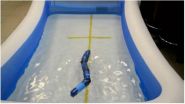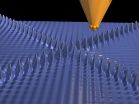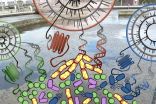An eel-lectrifying future for autonomous underwater robots
From cumbersome dinosaur undercover to anguilliform spy?
2014-11-26
(Press-News.org) On 24 October 2014, Sweden called off the hunt for a submarine after a week-long underwater search in the Stockholm archipelago. Triggered by a reported sighting of a Russian submarine, the alleged 'invasion' had been widely anticipated by military specialists and the media.
"Our assessment is that in the inner archipelago there was a plausible foreign underwater operation," Rear Adm. Anders Grenstad commented, "But we believe that what has violated Swedish waters has left."
"Whatever was there could not have been a conventional submarine," Grenstad said, but a "craft of a lesser type". He added that it was "not possible to state how big it was or to what country it belonged". "The operation is substantially complete. The vessels and amphibious units have gone to port and resumed normal preparedness," he said. But, was there, or wasn't there underwater activity in the area? Should the Swedish Navy be searching for something smaller than a dinosaur-like submarine?
Work by the Russian and the Allied militaries to develop underwater devices for information gathering are currently underway. Their aim is to reach areas which are difficult or even impossible for divers to reach; to inspect and clear mines on the sea floor, or even combat enemy scuba divers. The existing effort undertaken trains guard-dolphins; however, animal-rights-activists have opined that using dolphins for military reasons is inhumane, and may harm the world's ecology as rivals might seek to eliminate the threat by killing off the species. Hence, alternative strategies have been put in place to develop unmanned underwater systems as the replacement for military-trained dolphins.
To be able to be operable remotely, small, sophisticated and intelligent enough to operate autonomously underwater, these devices must be flexible, and able to operate in narrow spaces like a snake. Inspired by Anguilliform fish, due to their superior flexibility compared to the other fish forms, a team in Singapore has developed and built a prototype for an eel-like robotic fish. A snake-like form also gives the Anguilliform Robot amphibious potential, owing to the similarity in undulatory locomotion in water and on solid ground.
Mechanically, this robotic fish consists of N-links and N−1 joints, and is controlled by the torques applied to the joints. It was designed to move forward, and backward, as well as turnaround through different reference inputs driven by a three-dimensional coupled Andronov-Hopf oscillators, an artificial neural network, and an outer amplitude modulator. Prof. Jianxin Xu, co-author and researcher for the project reports:
We performed simulations and experiments on the robotic fish, equipped with a motion library to cope with different scenarios, and the results validate the effectiveness of the proposed controllers was able to swim forward and backward as predicted.
INFORMATION:
The full report on the prototype built and tested can be found in the Unmanned Systems journal, Vol. 2, No. 4, 2014.
[Attachments] See images for this press release:

ELSE PRESS RELEASES FROM THIS DATE:
2014-11-26
This news release is available in Japanese.
The deep ocean seems so remote that it is difficult to imagine any sort of human-generated change making an impact on deep-sea life. It is even more difficult to collect or examine evidence from the deep ocean to determine what those impacts might be. Enter the barnacle; a hard, sessile creature that looks like a tiny volcano and attaches to rocks, boat bottoms, and other hard substrates, where it filters ocean water to feed on tiny organisms. The barnacle holds clues about how climate change is affecting the deep ocean. ...
2014-11-26
KNOXVILLE - Warfare not only hastened human technological progress and vast social and political changes, but may have greatly contributed to the evolutionary emergence of humans' high intelligence and ability to work together toward common goals, according to a new study from the National Institute for Mathematical and Biological Synthesis (NIMBioS).
How humans evolved high intelligence, required for complex collaborative activities, despite the various costs of having a big brain has long puzzled evolutionary biologists. While the human brain represents only about two ...
2014-11-26
Published in the journal Nature, the discovery could revolutionise fuel cells and other hydrogen-based technologies as they require a barrier that only allow protons - hydrogen atoms stripped off their electrons - to pass through.
In addition, graphene membranes could be used to sieve hydrogen gas out of the atmosphere, where it is present in minute quantities, creating the possibility of electric generators powered by air.
One-atom thick material graphene, first isolated and explored in 2004 by a team at The University of Manchester, is renowned for its barrier properties, ...
2014-11-26
NGC 3532 is a bright open cluster located some 1300 light-years away in the constellation of Carina(The Keel of the ship Argo). It is informally known as the Wishing Well Cluster, as it resembles scattered silver coins which have been dropped into a well. It is also referred to as the Football Cluster, although how appropriate this is depends on which side of the Atlantic you live. It acquired the name because of its oval shape, which citizens of rugby-playing nations might see as resembling a rugby ball.
This very bright star cluster is easily seen with the naked eye ...
2014-11-26
Jülich, 26 November 2014 - In metals such as copper or aluminium, so-called conduction electrons are able to move around freely, in the same way as particles in a gas or a liquid. If, however, impurities are implanted into the metal's crystal lattice, the electrons cluster together in a uniform pattern around the point of interference, resembling the ripples that occur when a stone is thrown into a pool of water. Scientists in Jülich have, with the help of computer simulations, now discovered a combination of materials that strengthens these Friedel oscillations ...
2014-11-26
The Luxembourg Centre for Systems Biomedicine (LCSB) has succeeded for the first time in describing the complex relationships within an ecosystem in unprecedented detail. For their work, carried out in collaboration with US and Luxembourg partners, their model ecosystem was a "biological wastewater treatment plant". In it live numerous species of bacteria which are involved in the wastewater purification process.
LCSB director Prof. Dr. Rudi Balling stresses the medical importance of these research efforts: "Bacterial ecosystems also play a major role in our health. ...
2014-11-26
Although the van der Waals force was discovered around 150 years ago, it is still difficult to quantify when predicting the behaviour of solids, liquids, and molecules. Precise measurements were only possible up to now for single atoms or macroscopic objects. However, the van der Waals forces are particularly important at intermediate size, where they crucially co-determine the behaviour of complex molecules, such as biomolecules and proteins. They are also responsible for the functioning of certain adhesives and are the reason why geckos can adhere so amazingly well to ...
2014-11-26
This news release is available in French. The way people with autism spectrum disorder (ASD) gather information - not the judgement process itself - might explain why they gain different perceptions from peoples' faces, according to a new study from Hôpital Rivière-des-Prairies and the University of Montreal. "The evaluation of an individual's face is a rapid process that influences our future relationship with the individual," said Baudouin Forgeot d'Arc, lead author of the study. "By studying these judgments, we wanted to better understand how people with ...
2014-11-26
The precise movements of a young hammerhead shark have been tracked for the first time and are published in the open access journal Animal Biotelemetry. The study, which ran over a 10-month period, reveals important gaps in current efforts to protect these endangered sharks and suggests key locations that should be protected to help the survival of the species.
Hammerhead sharks, which have recently received new protections from the UN Convention on the Conservation of Migratory Species of Wild Animals, are experiencing drastic population declines in excess of 90% in ...
2014-11-26
The expression of a gene involved in female birds' color vision is linked to the evolution of colorful plumage in males, reports a new study from the University of Chicago. The findings, published Nov. 26 in the Proceedings of the Royal Society B, confirm the essential role of female color perception in mate selection and sexual dimorphism.
"This is the first time an aspect of the visual system in birds has been directly associated with plumage evolution," said Natasha Bloch, PhD, who authored the study while a graduate student in ecology & evolution at the University ...
LAST 30 PRESS RELEASES:
[Press-News.org] An eel-lectrifying future for autonomous underwater robots
From cumbersome dinosaur undercover to anguilliform spy?






